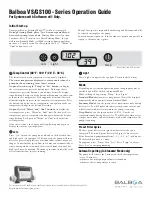
-
INSTALLATION
PRIMO PILOT
MANUAL
-
22
Note :
The heat pump circulator also ensures circulation in the sanitary
exchanger (if a sanitary tank is connected to the
PRIMO Pilot
).
Changing the speed of the heat pump circulator causes a change
in the fl ow rate in the sanitary exchanger.
6.6 - Heat pump circulator speed
The circulator speed is adjustable by setting
P227
or via the menu
«
installer
» / «
HP.CIRC
».
With the automatic summer/winter changeover function activated,
the
PRIMO
Pilot
decides when to enact the changeover from one
season to another, independently from the choice made by the user
via the on/off button.
The
PRIMO
Pilot
examines the exterior temperature for an extended
period of time (standby time) and uses the maximum exterior
temperature for heating («
TMAX.EXTER
», corresponding to parameter
P202
) as a reference point:
- If the observed exterior temperature is continually above
the maximum temperature, the
PRIMO
Pilot
switches to
summer mode.
- If the observed exterior temperature is continually below
the maximum temperature, the
PRIMO
Pilot
switches to
winter mode.
This function can be activated by setting parameter
P204
to
yes
.
Parameter
P205
allows the adjustment of the length of standby
time observed by the
PRIMO
Pilot
before the changeover from
one season to the other.
6.5.2.2 - Automatic summer/winter changeover
6.5.3 - Ambient temperature and heating
circulation control functions
Diff erential between the set ambient temperature and the measured
ambient temperature to activate or deactivate a heating request.
Only applicable if an ambient temperature sensor is connected.
Controlled by parameter
P247
.
6.5.3.1 - Ambient temperature sensor
hysteresis
Speed is adjustable through parameter
P230
.
Also adjustable through the installer menu
INSTALLer
: «
circ. pump
».
6.5.3.2 - Circulator pump speed
Heating circulation can be permanent or controlled by an ambient
temperature control.
If being controlled, the heating circulator will only be activated
when there is an ambient temperature request.
Control activated through parameter
P234
.
6.5.3.3 - Heating circulator control
6.5.3.4 - Anti-cold radiators
This function is only possible with an ambient temperature sensor.
Circulation is always controlled by the ambient temperature control.
When the set ambient temperature is reached, the
PRIMO
Pilot
adopts a lower set water temperature but continues to circulate so
the radiators do not become cold.
This function can be activated by setting parameter
P234
to
2
.
The set temperature can be lowered through parameter
P235
.
Note:
The cycle starts by default at 22:00 with a set temperature of 60°C.
This function activates a cycle which raises the temperature in the
domestic hot water tank above the set temperature so as to eliminate
any bacteria. This cycle is carried out at regular intervals.
If the function is activated, the cycle will be carried out at the chosen
frequency and on the day of week chosen:
- Activation / choice of frequency at
P272
: deactived,
monthly, or weekly.
- Choice of day at
P273
: if the frequency is weekly, the
cycle will be carried out each week on the selected day.
If the frequency is monthly, the cycle will be carried out
on the fi rst day chosen in the month (ex. fi rst Monday of
the month).
Note:
If holiday mode is engaged for more than 3 days, an anti-
legionellosis cycle will run at the exiting of holiday mode.
6.5.4.2 - Anti-legionellosis protection
6.5.4 - Functions related to the production of
domestic hot water
Allows the operation of the heating circuit at the end of the domestic
hot water heating cycle *when the tank’s temperature has been
raised suffi
ciently but before the cycle has been completed).
This function can be activated by setting parameter
P271
.
6.5.4.1 - Domestic priority sharing
7 - MAINTENANCE AND
TROUBLESHOOTING
• All work on the pilot must be carried out
by a qualifi ed professional.
• Follow all safety instructions!
• Disconnect the pilot from the electrical
supply before opening it.
• Except for certain operations, it is not
necessary to drain the system to work on
the components.
• If the system must be drained, close the
overfl ow valves and open the drainage
valve.
• Do not get water on the control
components.















































